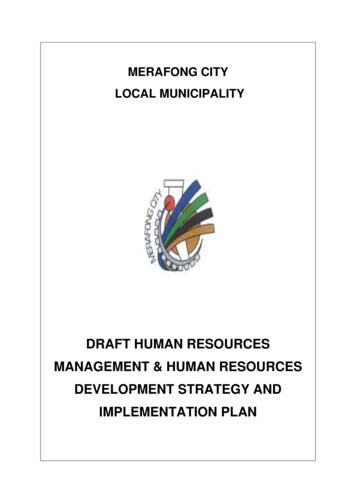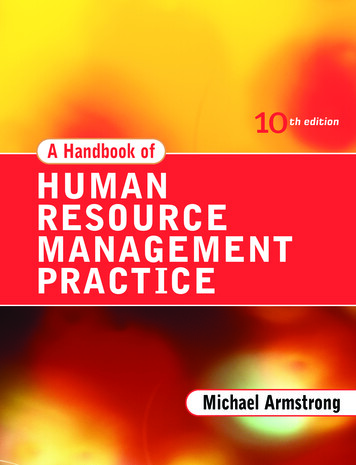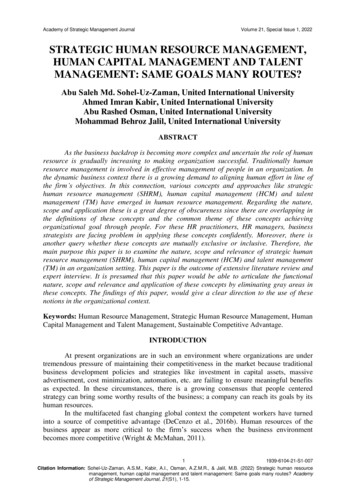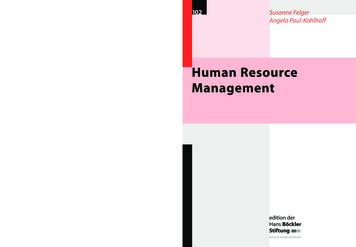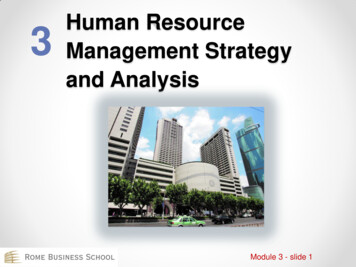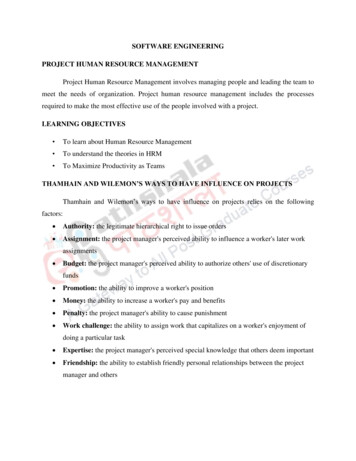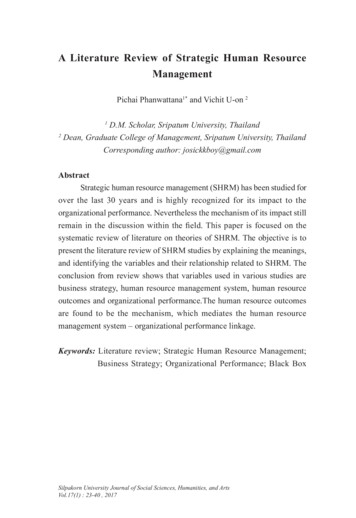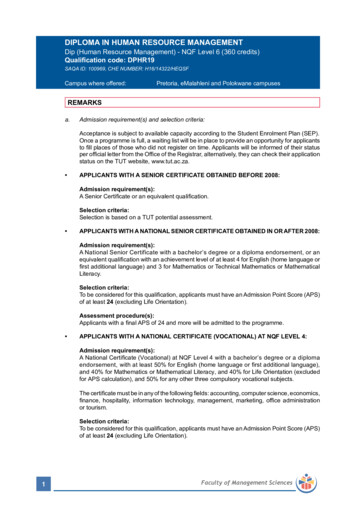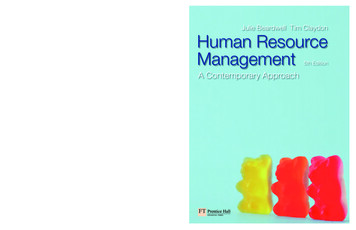
Transcription
Human Resource ManagementA Contemporary Approach5th EditionThe expert authors of this leading textbook take a critical viewon contemporary developments in human resourcemanagement, exploring a range of questions including: What effect does globalisation have on the practice of humanresource management?How is HRM developing in the rapidly growing economies ofChina and India?Why are skills and knowledge so crucial to an organisation’scompetitive advantage?Visit www.pearsoned.co.uk/beardwellfor valuable study resources!The text covers the most pressing and topical themes and debates of today – such as HR strategy, gender anddiversity, and employee rights, involvement and participation – whilst covering in depth the theory and practice ofthe operational aspects of HRM. The final part of the text compares trends in HRM around the world, with aparticular focus on India and China, as well as the influence of multinational corporations on the practice of HRM.Regular invitations to ‘Stop and think’, questions and activities, and recommended further reading enable you tolearn and research effectively. And a wealth of relevant and appealing case studies and examples include: human resource planning for the London 2012 Olympicsonline selection testing at Cadbury Schweppesemployee motivation at Harley-Davidsoncareer development at soft drinks giant Britvictalent spotting and the ‘corporate boot camp’ at multinational GEHuman Resource Management is written for undergraduate, postgraduate and MBA students, as well as thosestudying for the CIPD qualifications.The fifth edition of Human Resource Management is edited by Julie Beardwell,Associate Dean and Head of School, HRM at Leeds Metropolitan University andTim Claydon, Head of Department, HRM at De Montfort University, Leicester.ISBN 978-0-273-70763-9an imprint of9780273707639 COVER.indd 1Julie Beardwell Tim ClaydonHuman ResourceManagement5th EditionA Contemporary Approach5th EditionBeardwell Claydon Human Resource ManagementJulie Beardwell Tim Claydon9 780273 707639www.pearson-books.com2/22/07 6:45:17 PM
HUMA C00.QXD3/3/0812:55 PMPage iHuman Resource ManagementVisit the Human Resource Management, fifth edition Companion Website atwww.pearsoned.co.uk/beardwell to find valuable student learning materialincluding: Multiple choice questions for every chapter, with instant feedbackQuestions and exercises with suggested answers for self-directed studyLinks to useful websites to facilitate independent researchFlashcards of key terms and definitions for reference and revisionOnline glossary
HUMA C00.QXD3/3/0812:55 PMPage iiWe work with leading authors to develop thestrongest educational materials in business, bringingcutting-edge thinking and best learning practice to aglobal market.Under a range of well-known imprints, includingFinancial Times Prentice Hall, we craft high qualityprint and electronic publications which help readersto understand and apply their content, whetherstudying or at work.To find out more about the complete range of ourpublishing please visit us on the World Wide Web at:www.pearsoned.co.uk
HUMA C00.QXD3/3/0812:55 PMPage iiiFifth EditionHuman ResourceManagementA Contemporary ApproachEdited byJulie BeardwellLeeds Metropolitan UniversityTim ClaydonDe Montfort University, Leicester
HUMA C00.QXD3/3/0812:55 PMPage ivPearson Education LimitedEdinburgh GateHarlowEssex CM20 2JEEnglandand Associated Companies throughout the worldVisit us on the World Wide Web at:www.pearsoned.co.ukFirst edition published in Great Britain in 1994Second edition 1997Third edition 2001Fourth edition 2004Fifth edition published 2007 Longman Group Limited 1994 Financial Times Professional Limited 1997 Pearson Education Limited 2001, 2007All rights reserved. No part of this publication may be reproduced, stored in a retrievalsystem, or transmitted in any form or by any means, electronic, mechanical,photocopying, recording or otherwise, without either the prior written permission of thepublisher or a licence permitting restricted copying in the United Kingdom issued by theCopyright Licensing Agency Ltd, Saffron House, 6–10 Kirby Street, London EC1N 8TS.All trademarks used herein are the property of their respective owners. The use of anytrademark in this text does not vest in the author or publisher any trademark ownership rightsin such trademarks, nor does the use of such trademarks imply any affiliation with orendorsement of this book by such owners.ISBN: 978-0-273-70763-9British Library Cataloguing-in-Publication DataA catalogue record for this book is available from the British LibraryLibrary of Congress Cataloging-in-Publication DataHuman resource management : a contemporary approach / edited by Julie Beardwell andTim Claydon. — 5th ed.p. cm.Includes bibliographical references and index.ISBN-13: 978-0-273-70763-9ISBN-10: 0-273-70763-91. Personnel management—Textbooks. I. Beardwell, Julie. II. Claydon, Tim, 1949–HF5549.H78413 2007658.3—dc22200605247310 9 8 7 6 5 4 3 211 10 09 08Typeset in 10/12pt Minion by 30Printed and bound by Graficàs Estella, Navarro, SpainThe publisher’s policy is to use paper manufactured from sustainable forests.
HUMA C00.QXD3/3/0812:55 PMPage vContentsPrefaceGuided tourPlan of the bookHow to use this bookContributorsAcknowledgementsixxxivxvxvixixPart 1HUMAN RESOURCE MANAGEMENT ANDITS ORGANISATIONAL CONTEXTIntroduction to Part 1ObjectivesIntroductionDefinitions of HRMThe origins of HRMModels of HRMPhases in the HRM debateHRM in practiceThe impact of HRM on the HR functionConclusionSummaryCase study: Comparing different stylesof people managementReferences and further readingObjectivesIntroduction to strategic human resourcemanagementUnderstanding the business contextApproaches to the strategy-making processThe systemic approachThe rise of strategic human resourcemanagementExploring the relationship between strategicmanagement and SHRM: the best-fit schoolof SHRMThe resource-based view of SHRM707374757678783 Contextualising HRM: developing criticalthinkingAudrey Collin444567112125272828302 Strategic human resource managementNicky Golding59636531 An introduction to human resourcemanagementJulie Beardwell and Ian ClarkBest-practice SHRM: high commitment modelsHRM and performanceSHRM and performance: the critiqueMeasuring the impact of SHRM onperformance and the balanced scorecardConclusionSummaryQuestionsCase study: Café ExpressoUseful websitesReferences and further reading34ObjectivesIntroductionThe immediate context of HRMThe wider context of HRMWays of seeing and thinkingConclusion . . . and a new beginning?SummaryQuestionsExerciseCase study: Awkward squad promises arough ride at BlackpoolReferences and further readingPart 1 Case study:How well are we doing at work?838383879299108109111112112114117Part 2RESOURCING THE ORGANISATION3434363741434452Introduction to Part 21214 Human resource management and thelabour marketTim Claydon and Amanda ThompsonObjectivesIntroductionThe nature of labour marketsThe supply of labour122122122123125v
HUMA C00.QXD3/3/0812:55 PMPage viCONTENTSLabour demand133Labour market outcomes: the qualityof employment143Conclusion: labour market developments,job quality and the implications for theemployment relationship151Summary152Questions153Case study: Stuck on the ‘mummy track’ – whyhaving a baby means lower pay and prospects153References and further reading1545 Human resource planningJulie BeardwellObjectivesIntroductionDefining human resource planningThe traditional approach to HRPHuman resource planning – a contemporaryapproachThe advantages and disadvantages of humanresource planningHuman resource planning in practiceHRP and strategic HRMFuture directionsSummaryQuestionsCase study: London Olympics 2012References and further readingObjectivesIntroductionThe external contextThe internal contextKey stages in the recruitment and selectionprocessConclusionSummaryQuestionsCase study: International graduate recruitmentat GKNReferences and further reading157157158159ObjectivesIntroductionThe nature of discriminationWhy be concerned with equality and diversity?viPart 2 Case study:Teacher shortages254Part 3DEVELOPING THE HUMAN RESOURCEIntroduction to Part 32571728 Learning and 1992192202212212227 Managing equality and diversityMike Noon2332392442462492492502502512521576 Recruitment and selectionJulie BeardwellEquality and diversity policiesDevising equality and diversity policiesInstitutional discriminationThe process of discrimination in an organisationConcluding commentSummaryQuestionsCase study 1: A short case scenarioCase study 2: Safe future financeReferences and further reading225225225226228Audrey CollinObjectivesIntroductionThe changing world of work and organisationsLearning and developmentThe outcomes and process of learningThe process of developmentThe organisation as context for learning anddevelopmentControversial issuesConclusionsSummaryQuestionsExercisesCase study 1: Growing pains let changeblossomCase study 2: GE’s corporate boot campcum talent spotting venueUseful websitesReferences and further 013023039 Human resource development: theorganisational and national frameworkMairi WatsonObjectivesIntroductionTraining, learning, HRD and HRMHRD: the organisational contextHRD and national frameworks for vocationaleducation and trainingThe European dimension – VET in Europe307307307308311334336
HUMA C00.QXD3/3/0812:55 PMPage viiCONTENTSVET in the UKSummaryQuestionsExercisesCase study 1: Wealden District CouncilCase study 2: Smart cookiesUseful websitesReferences and further reading34035035135135135235335410 Management developmentMike Doyle359Objectives359Introduction359Defining management development360Management development as a strategicimperative361Organisational approaches to managementdevelopment363Organising management developmentprogrammes368Implementing and evaluating managementdevelopment programmes371Management development for differentcontexts and special needs383The future for management development:the need for new thinking and new practices? 401Summary404Questions405Exercises405Case study: Management development inMid-County NHS Trust405References and further reading407Part 3 Case study:Transforming Anglian Water41141511 The employment relationship andemployee rights at workIan ClarkObjectivesIntroductionDistinguishing contractual and statutoryemployment rightsThe contract of employmentDiscrimination in employment43543744044244845045145145245212 Establishing the terms and conditions ofemploymentSue Marlow and Trevor CollingObjectivesIntroductionCollective bargaining – a short overviewThe collective agreementChanges in collective bargaining sincethe 1980sHRM and collective bargaining‘New Labour’ and the contemporaryemployment relationshipEstablishing the terms and conditions ofemployment in the public sectorEstablishing the terms and conditions ofemployment in non-union organisationsSummaryQuestionsExercisesCase study: Fears about job destructionproved to be unfoundedReferences and further 8313 Reward and performance managementPart 4THE EMPLOYMENT RELATIONSHIPIntroduction to Part 4The regulation of working timeTermination of the employment contractEnforcement of contractual and statutoryemployment rightsNew rights at work?ConclusionSummaryQuestionsCase study: The pitfalls that follow a failureof best practiceUseful websitesReferences and further reading416416416417419432Alan J. Ryan and Julia Pointon487ObjectivesIntroductionThe development of reward systemsDesign and debatesMotivation as a mechanismNew day, new way, new pay?The psychological contractHRM and performance managementSome e study: Widgets Are UsReferences and further 22vii
HUMA C00.QXD3/3/0812:55 PMPage viiiCONTENTS14 Employee participation and involvementPeter Butler and Linda GloverObjectivesIntroductionDefinitionsHistory of EPIEPI: managerial motivesEPI practices in the workplaceWorks councils and consultation in theEuropean UnionNew management initiatives: from qualitycircles, to quality management, to ‘highperformance management’?SummaryCase study: Advanced ComponentsReferences and further readingPart 4 Case study:Malone Superbuy Ltd525525525526530534537546549555555557561Part 5INTERNATIONAL HUMAN RESOURCEMANAGEMENTIntroduction to Part 5ObjectivesIntroductionNational employment systemsGermany: the social partnership modelJapan: the enterprise-based modelThe American employment system:a managerial modelThree national systems: a summaryPatterns of change in national systemsWhere the USA leads the rest of the worldfollows?Change, convergence and divergence inemployment systemsviii59359359359459516 Human resource management in Chinaand IndiaLinda Glover and Anita Trivedi598ObjectivesIntroductionConvergence or divergence in Asia?China: economic growth and HRMIndiaSummaryCase study: Yummee Biscuits: Part 1Case study: Yummee Biscuits: Part 2References and further reading59859859960061562862962963017 International HRM56315 HRM trends and prospects:a comparative perspectiveIan Clark and Tim ClaydonConclusionSummaryQuestionsCase study: Chill enters cosy GermanboardroomsReferences and further reading564564564566566571576581582Phil Almond and Olga Tregaskis634ObjectivesIntroductionThe international strategic contextConfiguration of the international HRMfunctionKnowledge and the transfer of the HRpolicy and practice in internationalorganisationsCountry effectsSummaryQuestionsCase study: All change at LinkzReferences and further reading634634636651654661662662664Part 5 Case study:Global and local: the case of the inoperableHRM strategy667Glossary of terms and abbreviationsIndex669677640584591
HUMA C00.QXD3/3/0812:55 PMPage ixPrefaceThis fifth edition is the first edition of this text that has not been co-edited and contributed toby Len Holden. The book was in many ways Len’s brainchild and the fact that the book goeson even though he has relinquished his role is a tribute to the quality of the vision that he andIan Beardwell shared nearly fifteen years ago. As new co-editors we have tried to ensure thatthis edition maintains the analytical and critical standard that they set in earlier ones.HRM is a continually evolving field of practice and study. In its successive editions thisbook has tried to reflect critically upon new developments as the issues and policies that havebecome associated with it have multiplied considerably. Previous editions have traced thedebates over the role of the HRM specialist within organisations, the role and nature of HRMin relation to organisational change initiatives such as total quality management (TQM),and the strategic role of HRM and its effect on organisational performance. They alsoaddressed the implications for HRM of the emergence of new concepts such as the learningorganisation and the knowledge-based organisation and new approaches to employeeinvolvement (EI) and empowerment.In the last edition we noted how in academic circles the search for a universal HRM paradigm has given way to an emphasis on understanding how HRM operates in diversesituations and what contribution it can make to the effectiveness and profitability of theorganisation. Particular attention was paid to concepts such as high performance worksystems, the resource-based view of HRM and ‘bundles’ of HR policies. That editionalso examined the operation of HRM across national boundaries, reflecting the growingimportance of multinational companies and the globalising trends in the world economy.This edition continues to explore these themes and to reflect further developments in thefield, including changes in employees’ legal rights, developments in employee involvementand the implications of the continuing emphasis on the need to raise skills and compete inworld markets on the basis of skills and knowledge. We have paid particular attention to thefinal section dealing with comparative and international HRM in order to address more fullythe issues for HRM raised by globalisation. There are new chapters that discuss whether distinctive national patterns of HRM can survive in the face of US-led globalisation, how HRMis developing in the rapidly growing economies of China and India, and the ways in whichmultinational companies are influencing not only HRM ideas and practice across the globebut also the national and international policy environments within which HRM operates. Asingle volume cannot encompass the huge area in and around the HRM sphere, and weapologise for any omissions. Nevertheless, we have covered the broad sweep of the HRM fieldand some aspects in considerable detail.We would again like to thank our long-standing contributors and those who are makingtheir first appearance in this edition for their hard work and willing cooperation in gettingthis edition to press. We would also like to thank partners, family members and colleagues fortheir help and support in the arduous process of academic writing. Finally, we would like tothank our editors at Pearson for their enthusiastic help and encouragement.Julie BeardwellTim Claydonix
HUMA C00.QXD3/3/0812:55 PMPage xGuided tourChapter 2Strategic human resourcemanagementNicky GoldingObjectives To indicate the significance of the business context in developing an understanding of themeaning and application of SHRM. To analyse the relationship between strategic management and SHRM. To examine the different approaches to SHRM including:Objectives provide an overview ofthe topics to be covered in eachchapter, giving a clear indication ofwhat you should expect to learn.– the best-fit approach to SHRM;– the configurational approach to SHRM;– the resource based view of SHRM– the best-practice approach to SHRM. To evaluate the relationship between SHRM and organisational performance. To present a number of activities and case studies that will facilitate the reader’sunderstanding of the nature and complexity of the SHRM debate, and enable the readerto apply their knowledge and understanding.Introduction to strategic human resource managementThis chapter charts the development of strategic human resource management. It assumesa certain familiarity with the evolution of HRM, early HRM models and frameworks andtheir theoretical underpinning as discussed in other chapters and particularly Chapter 1.The aim of this chapter is to provide a challenging and critical analysis of the strategichuman resource management literature, so that you will be able to understand the synthesis both within and between strategic human resource management and strategicmanagement in its various forms.Since the early 1980s when human resource management arrived on the managerialagenda, there has been considerable debate concerning its nature and its value to organisations. From the seminal works emerging from the Chicago school and the matching modelof HRM (Fombrun, Tichy and Devanna, 1984) the emphasis has very much concerned itsstrategic role in the organisation. Indeed the now large literature rarely differentiates betweenhuman resource management (HRM) and strategic human resource management (SHRM).While some writers have associated HRM with the strategic aspects and concerns of ‘best-fit’,THE SYSTEMATIC APPROACHFigure 2.2Emergent strategyIntstr endeate trategyEmergent strategyFigures are used to illustratekey points, models, theoriesand processes.Source: Reprinted by permission of Harvard Business Review. From ‘Crafting Strategy’ by Mintzberg, H., July–August 1987. Copyright 1987 by the Harvard Business School Publishing Corporation, all rights reserved.is these pluralist tensions that are sometimes ignored in certain branches of the SHRM literature, most notably the ‘best-practice’ approach.Stop & think: readers arefrequently invited to reflectcritically, challenge theirassumptions and relate totheir own experience.Stop&thinkCan you think of reasons why an intended strategy might not be realised? Why dostrategies sometimes emerge?Illustrate your answers with examples from your own experience. If you do not haveorganisational examples, reflect upon your personal development so far.What factors have influenced your choice of university? degree subject? career?, etc. Have youfollowed your original plans? What changes have you made? Have new strategies emerged?Using Mintzberg’s model, you could plot your development so far on a time-line, identifyingwhere and why planned strategies have failed to be realised while new ones have emerged.The systemic approachThis leads us on to the final perspective identified by Whittington (1993, 2001), the systemicapproach. The systemic approach suggests that strategy is shaped by the social system it operates within. Strategic choices, therefore, are shaped by the cultural and institutional interestsof a broader society. So for example, state intervention in France and Germany has shapedHRM in a way which is different to the USA and the UK. A key theme of the systemicapproach is that ‘decision makers are not detached, calculating individuals interacting inpurely economic transactions’ (Whittington, 2001: 26) but are members of a community‘rooted in a densely interwoven social system’. Therefore in reality, organisations and theirmembers’ choices are embedded in a network of social relations (Whittington, 1993). Thusaccording to this approach, organisations differ according to the social and economic systemsin which they are embedded.41x
HUMA C00.QXD3/3/0812:55 PMPage xiGUIDED TOURCHAPTER 2 STRATEGIC HUMAN RESOURCE MANAGEMENTActivityTry to answer these questions with regard to your organisation or one you are familiar with.Alternatively, you could use the case study ‘Café Expresso’ at the end of this chapter.Activities appear throughout thetext to reinforce learning withproblems and practical exercises.This approach has further implications for the role of human resource managers in a firm, asthey need to understand the economic consequences of human resource practices and understand where they fit in the value chain. Barney and Wright (1998: 42) suggest that the humanresources function needs to be able to explore the following questions: Who are your internal customers and how well do you know their part of the business?Are there organisational policies and practices that make it difficult for your internalclients to be successful?What services do you provide? What services should you provide? What services shouldyou not provide?How do these services reduce internal customers’ costs/increase their revenues?Can these services be provided more efficiently by outside vendors?Can you provide these services more efficiently?Do managers in the HR function understand the economic consequence of their jobs?The value of an organisation’s resources is not sufficient alone, however, for sustainable competitive advantage, because if other organisations possess the same value, then it will onlyprovide competitive parity. Therefore an organisation needs to consider the next stage of theframework: rarity.RarityThe HR manager needs to consider how to develop and exploit rare characteristics of a firm’shuman resources to gain competitive advantage.Nordstrom is an interesting case, because they operate in a highly competitive retail industry where you would usually expect a lower level of skill and subsequently high labourturnover. Nordstrom, however, focused on individual salespeople as a key source of its competitive advantage. It therefore invested in attracting and retaining young college-educatedpeople who were looking for a career in retailing. To ensure horizontal integration, it alsoprovided a highly incentive-based compensation system (up to twice the industry average)Box 2.2Please read the following extract:Nordstrom exists in the highly competitive retailing industry. This industry is usually characterised as having relatively low skill requirements and high turnover for sales clerks.Nordstrom, however, has attempted to focus on individual salespersons as the key to its competitive advantage. It invests in attracting and retaining young, college-educated sales clerkswho desire a career in retailing. It provides a highly incentive-based compensation system thatallows Nordstrom’s salespersons to make as much as twice the industry average in pay. TheNordstrom culture encourages sales clerks to make heroic efforts to attend to customers’ needs,even to the point of changing a customer’s tyre in the parking lot. The recruiting process, compensation practices, and culture at Nordstrom have helped the organisation to maintain thehighest sales per square foot of any retailer in the nation.Boxes contain a variety of businessexamples to put theory into practice.Source: Barney J.B. and Wright P.M. On becoming a strategic partner: the role of human resources in gainingcompetitive advantage, Human Resource Management, Spring, 1998, vol. 37, no 1, 34.QuestionHow did Nordstrom exploit the rare characteristics of their employees?CHAPTER 5 HUMAN RESOURCE PLANNING54SummaryThe chapter began by outlining seven key objectives and these are revisited here. The Summary allows you to recapand review your understanding ofthe main points of the chapter. Human resource planning can be interpreted in a number of different ways. For some itmeans the same as manpower planning, for others it is significantly different and hasmany similarities to HRM. The definition used in this chapter relates to HRP as a set ofdistinct activities that incorporates both the hard elements associated with manpowerplanning and some of the softer elements associated with HRM.The key stages in the traditional human resource planning process are investigation andanalysis, forecasting demand and supply, developing action plans to address any imbalance, implementing the plans and evaluating their effectiveness.Methods of demand forecasting discussed are time series, ratio analysis, work study, managerial judgement, the Delphi technique and working back from budgets. Quantitativemethods can be problematic as the extrapolation of past data might be inappropriate in achanging environment but they can provide a reasonable starting point for forecasts.Qualitative methods are more flexible but can be manipulated for political ends. Supplyforecasting tends to focus mainly on various analyses of labour turnover and stability andmovement through an organisation. Quantitative analysis can help to highlight problemareas but gives little indication about how problems might be addressed. Qualitative datacan help to address this gap but can sometimes be difficult to obtain. Organisations canexacerbate problems if they are not seen to act on the information they receive.A more contemporary approach to HRP aims to enable the organisation to adapt to anuncertain and changing environment and emphasises the need to develop a well-trainedand flexible workforce. Variants to HRP include micro-planning, contingency planning,succession planning, skills planning and soft human resource planning.The main advantages of HRP are that plans can help reduce uncertainty, can build flexibility and can contribute to vertical and horizontal integration. The key disadvantages relateto difficulties of predicting an uncertain future, the lack of necessary data to make accuratepredictions and the absence of clear business plans.Evidence of HRP in practice is varied but the dominant approach seems to view HR as the‘dependent variable’ and tends to be tentative and incremental rather than systematic.HRP’s main role in SHRM is as a means to facilitate the integration of HR strategy withbusiness strategy and to ensure that HR policies and practice are compatible with eachother. In addition, some studies associate formal planning activity with improved organisational performance, particularly if planning is sustained over a number of years. The keyemphasis, however, needs to be on building adaptability and managing change.QUESTIONS1 To what extent can forecasting activity influence the effectiveness of human resource plans?Questions can be used forself-testing, class exercisesor debates.2 Why should organisations be concerned with labour turnover and what steps can they taketo address the issue?3 Contemporary organisations increasingly operate in a dynamic and uncertain environment.Does this reduce or increase the need for human resource planning activity? Justify youranswer.186xi
HUMA C00.QXD3/3/0812:55 PMPage xiiGUIDED TOURCHAPTER 2 STRATEGIC HUMAN RESOURCE MANAGEMENTCASE STUDYCase studies, at the end of eachchapter and part, help consolidateyour learning of major themes byapplying them to real-life examples.Café ExpressoCafé Expresso is one of the three main players in the‘coffee house’ industry, which now has more than6000 stores across the globe, 500 of which are in theUK and Ireland. They employ 7000 staff in the UKalone and serve 35 million customers in their storesacross the globe each week.The coffee industry is particularly robust, withcoffee being the second most valuable commodity inthe world after oil, with global retail sales estimatedto be 39.2 billion. A total of 6.7 million tonnes ofcoffee were produced annually in 1998–2000, whichis forecast to rise to 7 million tonnes by 2010.The number of coffee bars in the high street hasincreased considerably in recent years, with themarket being dominated by three main players. The‘coffee house’ business therefore, is very competitivewith coffee chains constantly looking for innovativeways of achieving sustainable competitive advantage,to remain ahead of their rivals.Café Expresso had enjoyed first mover advantagein the marketplace and had rapidly grown to numberone position, which they had re
Human Resource Management is written for undergraduate, postgraduate and MBA students, as well as those studying for the CIPD qualifi cations. 5th Edition The fi fth edition of Human Resource Management is edited by Julie Beardwell, Associate Dean and Head of School, HRM at Leeds Metropolitan University and



